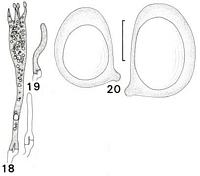|
 Clavaria ardosiaca Clavaria ardosiaca
BiostatusPresent in region - Indigenous. Endemic
Images (click to enlarge)
Caption: Figs. 18-20 Clavaria ardosiaca. 18, basidium (not to scale): note multiguttulate contents and
long, slender sterigmata. 19, young basidia with conspicuous clamp connections (not to
scale). 20, spores. TENN no. 42264. Scale bar = 5 µm. | 
Caption: Microfiche 1-14. Clavaria ardosiaca. TENN no. 42264. |
Article: Petersen, R.H. (1988). The clavarioid fungi of New Zealand. New Zealand Department of Scientific and Industrial Research, Bulletin 236: 170 pp. Wellington:.
Description: Fruit bodies up to 12 x 0.5 cm, simple clubs, scattered, gregarious or cespitose in groups of
up to 30 individuals, narrowly fusiform to subcylindrical, arising from discrete or common
whitish mycelial patches. Club slate-grey to deep slate-grey ("Quaker-drab", "deep purplish
grey", "purplish grey", "neutral grey", "deep neutral grey"), opaque, with mat texture, often
longitudinally wrinkled or dimpled, equal; flesh concolourous outward, inward whitish and
stuffed; apex rounded. Stipe equal, hardly distinct from hymenium, deep grey-brown
("benzo-brown" upward, "drab" downward). Taste faintly sweet; odour none, or tardily and
weakly of garlic.
Macrochemical reaction: FCL = negative.
Tramal hyphae significantly inflated, adherent, thin-walled, clampless, hyaline; secondary
septa rare; gloeoplerous hyphae occasional, uninflated, refringent under phase contrast.
Subhymenium well-developed, pseudoparenchymatous. Hymenium thickening, adherent;
basidia (Figs 18, 19) clavate, clamped, contents granular when young, multiguttulate when
mature; sterigmata 4, stout, curved, somewhat divergent.
Spores 8.3-11.2 x 6.8-8.3 µm (E = 1.19-1.50; Em = 1.32; Lm = 9.83 µm), broadly ellipsoid,
flattened slightly adaxially, smooth, thin-walled; contents uniguttulate when mature; hilar
appendix thick, prominent, papillate.
Habitat: On soil and humus under kauri (Agathis australis).
Notes: This is a slate-grey version of Clavaria albo-globospora, with which it was growing. Fruit
bodies are striking when once seen but the dark colour obscures them in the field.
Clavaria muscula from Australia is very similar in fruit body colour, but does not produce
cespitose clusters of clubs, and forms smaller spores (6.7-8.1 x 5.2-6.3 µm; Lm = 7.51 µm)
than C. ardosiaca. These species seem to stand in much the same relative position as C.
alliacea (q.v.) and C. albo-globospora.
|